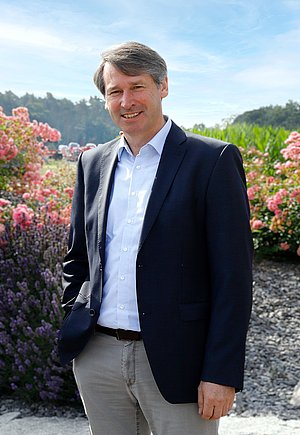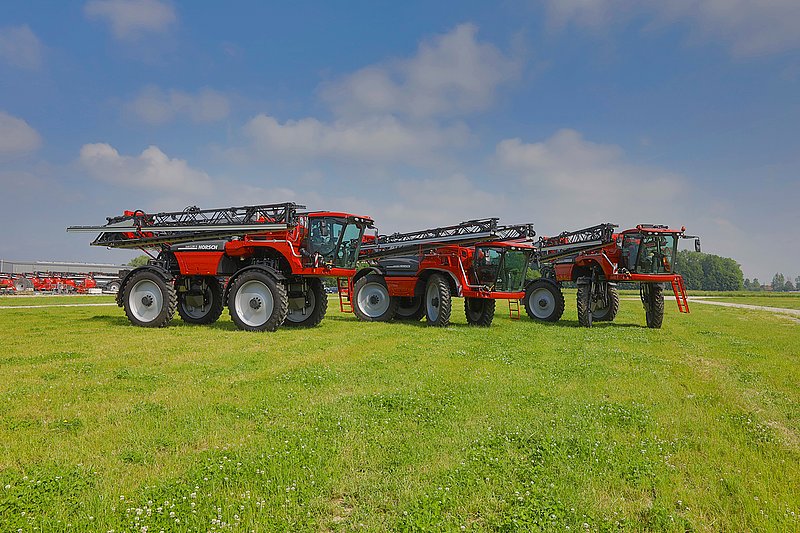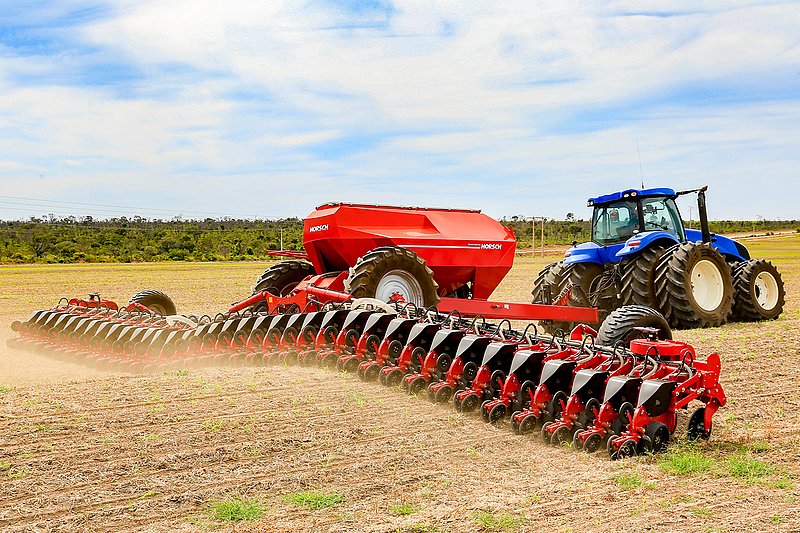Crop care on all continents
Theo Leeb, the managing director of the HORSCH LEEB Application Systems GmbH, talks about the objectives the company pursues with its crop care technology, how the markets are going to develop and where the focus for self-propelled sprayers in the market is on.

terraHORSCH: Which developments do you observe in the international market with regard to crop care technology?
Theodor Leeb: In the past two years the topic tank capacity was increasingly discussed in the export markets. So far there normally has been a demand for a capacity of max. 5,000 litres. In the meantime, there have been changes and the need for larger tanks increases. We are already offering tanks with a capacity from 6,000 to 8,000 litres for export. This customer demand among others originates from the idea of efficiency. It makes sense to have more water respectively more liquid with you in the field to ease water logistics. However, with a growing capacity we also had to consider the total weight of the machine. Due to a newly developed concept with a front cabin and a 50:50 weight distribution we can now build a machine with a capacity of 6,000 or 8,000 litres which does not weigh more than a competitor machine with a 4,000 litres tank. The weight distribution for machines with a middle cabin however is 70:30. These machines are very heavy at the rear because of the axle load and thus the tank content is limited. Another development is the increasing demand for larger boom width beyond today’s usual 30 to 36 metres. We rather know this from markets like the Netherlands. The reasons are topological. There are a lot of irrigation ditches which are laid out for 50 metres. In France, the situation is similar. In total, in the export markets the demand for larger working widths increases. We are talking about widths of partly up to 50 metres.
Finally, it is about making the performance of the machine less dependent on the user and to identify performance reserves. This is the objective we pursue with automation.

terraHORSCH: Why does the water application rate in the markets tend to increase?
Theodor Leeb: The farmers in the US partly have adsorption problems because of little water, high speeds and wind. In combination with suboptimal wetting efficiency decreases. The problem increases exponentially. More water normally improves the wetting performance. The topic of water application rate was driven by the idea to achieve a high output with little sprayers to increase efficiency. In this respect the pendulum might have swung extremely in one direction, but in the meantime, this has been corrected. If you regard the history of the low water application rates, you will notice that it was driven by the traditional self-propelled sprayers with a tank capacity of 2,000 to 4,000 litres and which had to be used as efficiently as possible on many hectares. In this case the most important lever for area output was and still is the applied quantity of water per hectare.
terraHORSCH: What are the major differences in the different markets?
Theodor Leeb: In the export markets we sell a lot of self-propelled sprayers. Especially in the Ukraine, in Russia, Kazakhstan or in North America respectively Canada. Brazil is added to the list right now and in Australia we plan to launch the sprayers this summer. In North America there are a lot of farmers where the owners themselves drive the machine, especially in family-run farms. This is why they have very high requirements with regard to ease of use and driving comfort. In other arable farming regions, however, the focus is on a simple, solid handling as due to the sizes of the farms the machines are driven by external staff. In this case we have to meet the challenge that the machines are also driven by people who are less technophile. In the meantime, we can offer good approaches to solve this problem. With regard to the basics like work quality, performance and reliability the requirements are the same – whether in North America, Brazil, Russia etc. The basic elements have to fulfil the requirements. As I already said: the differences are in the comfort topics and the handling features. In this respect the demands of the Western markets like US and Canada are considerably higher. It may happen that they express special wishes which other farms do not attach great importance to – for example with regard to cupholder or leather seats. One is prepared to spend more money on such things, the other does not care too much about it. It’s similar to buying a car.
terraHORSCH: How important is the focus on the driver when a machine is developed?
Theodor Leeb: We have different equipment options with regard to the handling of the machines. Here, too, we notice global differences. While some markets attach great importance to performance, reliability and a good application quality, other markets additionally demand a higher degree of automation, comfort features and want to achieve the optimum with regard to spraying quality. This is why we offer a wide range of sprayers. We want to be flexible to meet the customers‘ requirements. I also notice that the customers more and more require highly automated work flows and even complete autonomy. With a high degree of automation decisions how to do what and when can be taken in advance. Our objective is that the driver only carries out monitoring tasks. Decision processes are to be documented and traceable afterwards. These requirements mainly come from large farms with a lot of employees. These often are farms in Russia, Brazil or the Ukraine who have to meet the management challenge with regard to the vehicle fleet and staff. Finally, it is about making the performance of the machine less dependent on the user and to identify performance reserves. This is the objective we pursue with automation. In my opinion, this finally is the preliminary stage respectively the prerequisite for autonomy. In this context we take the whole work flow into account – i.e. from track planning to logistic topics. These machines will, of course, be connected with the internet via HorschConnect. This way, we can see exactly when and why the driver has to intervene during the work process because for example he has to avoid an obstacle in the field or a nozzle is blocked. Based on this information, we can continuously optimise and develop our system further. It also serves as an indicator of how far we still are away from a completely autonomous solution.
terraHORSCH: Why is such a wide range of self-propelled sprayers necessary?
Theodor Leeb: I see two driving factors for this variance. On the one hand, depending on the arable farming region there are different crops which in turn make special demands on track width and clearance. On the other hand, the homologation restrictions for road service provide different frame conditions. They are not uniform for Europe, much less on a global scale. Machines that are approved in France for example must not exceed an outside width of 2.55 metres to be allowed to go at 40 km/h on the road. The US, Russia and Brazil are less restrictive by far. The admissible outside width, of course, essentially influences the design of the machine. You can see this in the different frame concepts, but also in the different boom designs. In Europe, for example, we have to take quite a lot of technical effort to fold wide booms to a width below 2.55 metres. For the export markets we make full use of the available space and fold to an outside width of 3.2 metres. Thus, the cross section of the individual boom segments is larger, what in turn means more stability. This makes sense for the export markets as the operational speeds partly are beyond 30 km/h and as for example in Brazil due to two harvests the sprayer is used almost the whole year round. The hectare output, thus, cannot be compared to European farms. Owing to the different agronomic and regulatory requirement it makes sense to cover the whole sector with several types of sprayers.
terraHORSCH: In Brazil, in some regions there is an intensive formation of terraces. With large working widths is this an issue with regard to the boom control?
Theodor Leeb: The fields in Brazil are very rough and often are uneven. Among other the result of deliberately laid terraces and direct seed over many years. This, of course, is a challenge for the chassis and the suspension. But with our newly developed wheel suspension we are optimally prepared. In Brazil the terraces rather are ridges which were laid to guide the water. In North America the challenge are artificial water ditches which were deliberately cut into the fields for irrigation. On principle, our boom control system BoomControl is ideal to guide the boom perfectly above the population even in extreme conditions. But there is one point I would like to improve: driving over terraces or driving through irrigation ditches. Imagine the vehicle drives into a ditch. The machine tilts towards the front, the boom at the rear goes up. BoomControl realises this and regulates the boom downwards again. In the next moment the rear axle drives into the ditch. Because of the simultaneous downward movement of the boom and the machine, the boom might get very close to the population. Our idea to avoid this is as follows: If the self-propelled sprayer drives into a hollow or down from a terrace, the chassis performs a rotary movement to the front or to the rear. We take it up with a gyroscope and immediately control the boom actively to avoid a double downward movement. This guarantees safety without the driver having to intervene. But we are still in a very early development stage so I cannot make a statement with regard to availability.
Because of the current discussion about the diesel motor even more stricter limit values might be required in Europe in the future. But we hope that this will not come true.

terraHORSCH: Do you plan to build self-propelled sprayers in Brazil on site? And If yes, what is your time frame?
Theodor Leeb: Brazil is an important market for us which is growing continuously, and we want to break into this market. This is why we expand our site in Brazil to be able to manufacture our machines on site. Another advantage of a production on site are local content or customs topics. The first prototype is to be built this year. A realistic date for serial production will be as of 2023.
terraHORSCH: The clearance of the first “long-legged” self-propelled HORSCH sprayer was 1.6 metres – isn’t it enough?
Theodor Leeb: Our experiences with the PT 350 showed that especially for sunflowers a clearance of 1.6 metres is a compromise. It might work in some years, but there are also years when the sunflowers grow to a height of more than 1.8 metres. As the head is the sensitive part, there might be damages. This is why for our new models VL and VN we offer a height adjustment for a clearance of two metres as an option. But the experiences with the PT 350 also showed that for maize in the majority of cases a clearance of 1.6 metres is enough. Therefore, the standard version of the VL and VN comes with a clearance of 1.6 metres.
terraHORSCH: How about the topic nozzles and nozzle control? In Europe pulsing is pushed enormously – what is it like on other continents?
Theodor Leeb: The awareness and the interest of our customers grow considerably. In North America where the first PWM systems were launched about 25 years ago, it has become standard almost everywhere. For the large fields in Brazil, Russia, Ukraine etc. I do not see such a great demand as due to the field structures the main advantage of pulsing, CurveCompensation, usually is not used to such an extent as the headlands are laid out rather straight and there are almost no obstacles in the field that have to be avoided. In this case, our well-proven AutoSelect is completely sufficient. It can also be used to realise different application rates and operational speeds.
terraHORSCH: What are the developments with regard to the emission standard for self-propelled sprayers? Are there discussions about a global equalisation?
Theodor Leeb: To remain competitive in the different markets, the emission values, of course, have to be ok. In Europe, emission level 5 applies at the moment, in South America, Russia and the Ukraine level 3 is sufficient. As meanwhile the exhaust after-treatment system represents an essential part of the costs of an engine, we offer both emission levels. I do not see an equalisation in the medium term. The export markets might perhaps catch up slowly and reduce the distance to Europe. However, because of the current discussion about the diesel motor even more stricter limit values might be required in Europe in the future. But we hope that this will not come true.
terraHORSCH: From a global point of view the self-propelled sprayer is a very interesting tool in the crop care sector. What is your market expectation?
Theodor Leeb: Every year about 9,000 self-propelled sprayers are built worldwide. The distribution, however, is rather unequal. The main markets definitely are North and South America. Europe is relatively constant. In my opinion, the biggest growth potential for self-propelled sprayers is in Eastern Europe. Our objective is clear: We want to achieve a significant market share in all markets. But I am realistic, and I know that this will happen at a different speed depending on the respective country. We already have acquired a top-ranking position in many European countries. Beyond Europe I notice that the demand for our machines in the Eastern European countries, i.e. countries with a high import share of spraying technology, is very high. On the one hand, this is due to our excellent sales and service team, but on the other hand to the openness of the customers for European technology. In the traditional self-propelled sprayer markets North and South America, it is a little bit different. In these countries you have to set yourself apart from the top dogs from a technical point of view. The first feedback and the sales, however, show that we offer exactly the technical developments the farmers are waiting for. This is why I am very confident. In Australia where we will launch our sprayers this summer. The launch was delayed because of Covid-19 as we were not allowed to travel. In this market, too, we see quite a lot of potential for our machines.
Another important point is the ISOBUS and GPS steering systems complex. Especially with our global orientation it is extremely important to be open to a large number of different systems and providers. I notice that depending on the region there is a preference for different manufacturers of terminals and steering systems. This is the reason why we, of course, offer a standard ISOBUS interface for the application terminals and an intelligent universal interface for the steering systems. Moreover, we have a camera system which can be used to steer automatically in row crops.
terraHORSCH: Where are the markets that focus on trailed technology?
Theodor Leeb: The farmers openly discuss if an expensive self-propelled sprayer is profitable for them or if a cheaper trailed machine combined with a comfortable tractor which they for example already use for sowing maize is sufficient. With regard to comfort or application options there is not much difference compared to self-propelled sprayers. The same technologies are used in both. In the North of Canada for example less maize is grown. So you do not need high clearance and you could perfectly manage with trailed machines. For large farms a combination of self-propelled sprayer and trailed technology in my opinion is the most reasonable solution from an economical point of view. The farmers are already ready for this, but the appropriate technology is still not available in these countries. This is why we are going to extend the Leeb AX line with an export version with a larger barrel capacity and a spraying boom that will be adapted to the conditions.
terraHORSCH: How do the 3-point sprayers fit into your global strategy?
Theodor Leeb: There is a stable market for 3-point machines, mainly Germany and France. In France, the terrain is very hilly, especially in the South. It is difficult to work with a trailed sprayer in such conditions. Self-propelled sprayers are not in line with the farm sizes. This is where a combination of 3-point machines with a front barrel is ideal. A small self-propelled sprayer with good traction and weight distribution – this makes sense and will not change significantly in the years to come. In our opinion, the same is true for Great Britain. For very small farms in Poland or the Czech Republic we do not just yet have the perfect technology. For the 3-point machines we partly use the same technology as for the self-propelled sprayers with regard to the boom control system, nozzle control and cleaning. The Leeb CS, that’s the name of the new sprayer line, will be equipped with the well-known systems BoomControl, CCS Pro and AutoSelect. If we take a look at the crop care sector, our many innovative solutions set new standards in Europe. The next step now is to make the advantages of our application technology available to the farmers to the full extent. This is a wonderful challenge which I am really looking forward to. We continuously work on us and on our products and want to offer the farmers the best possible solutions – we then have a good chance to become a market-leading company in our sector worldwide.